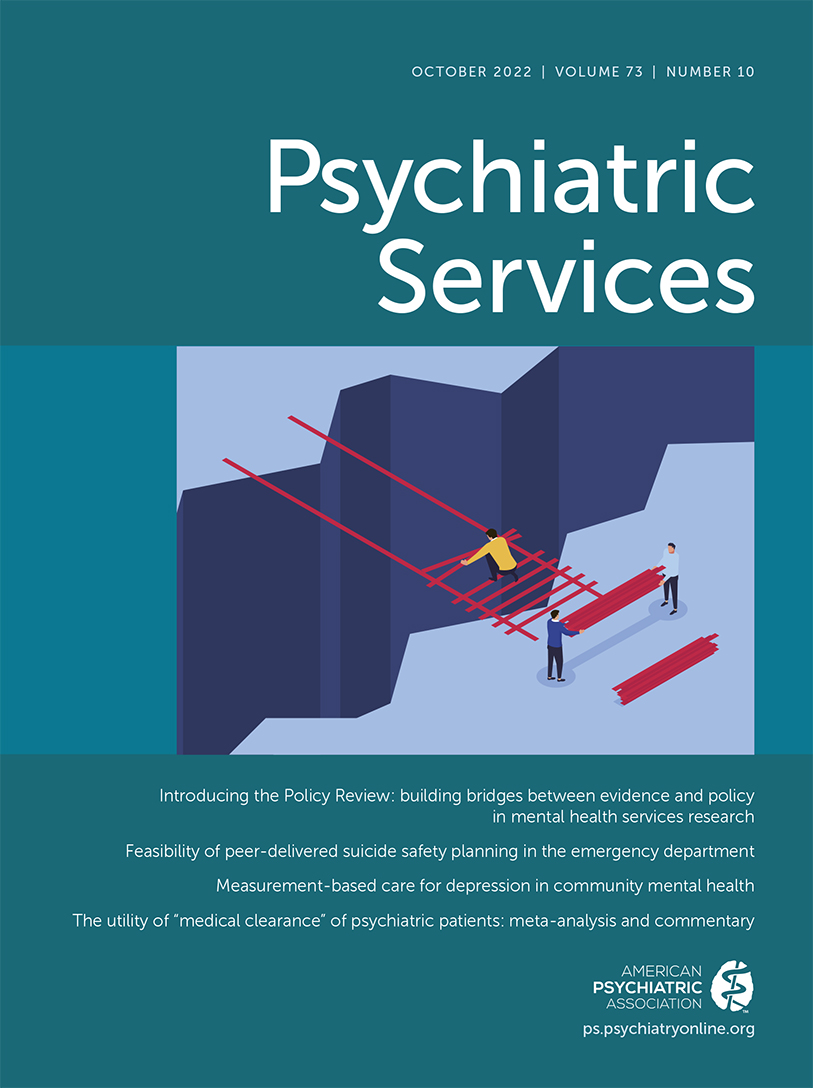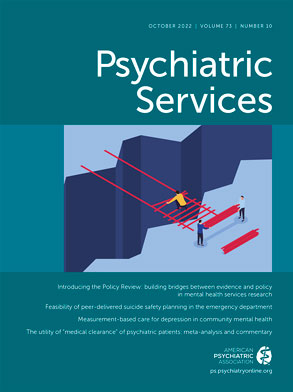Research in Mental Health Policy
Evidence-based policy research focuses on producing knowledge and the best evidence regarding health policies that are most likely to improve the quality of health care and create conditions for effective, safe, equitable, efficient, timely, and patient-centered care. Evidence-based policy research can examine approaches to enhance policy adoption, identify effective policy elements, or study systemwide outcomes of policies once they are implemented (
4). These types of research can inform how laws and regulations affect the delivery of evidence-based practices and how policies can either counteract or perpetuate structural racism and health disparities, including disparities in health care.
A relatively small number of empirical studies have attempted to develop evidence-based policy making in the fields of mental health and substance use (described here as “mental health policy”) (
5). These studies, including the RAND Health Insurance Experiment, the Substance Abuse and Mental Health Services Administration (SAMHSA) national demonstration projects, and New York State’s assisted outpatient treatment program (
6), have had an outsized impact on care delivery and organization, highlighting the value of this type of research (
7). Nonetheless, the fragmented funding and service delivery service sectors in the United States have created challenges in implementing these studies and moving their findings into practice. This decentralization makes it difficult to implement findings from this research uniformly, necessitating buy-in from numerous provider organizations and states. Outcomes of this type of work are difficult to measure, measurements often rely on administrative data, and, in the absence of randomized designs or rigorous implementation science techniques, outcomes are difficult to ascribe to particular policy interventions.
Several strategies applied at different phases of research can be effective approaches to informing and improving mental health policy, such as developing research questions, selecting methods and outcomes to be considered, and planning how to disseminate findings (
8). For example, researchers could partner with policy makers, advocacy groups, and community members to identify salient questions and help disseminate findings (
9). Researchers could develop designs to examine unique aspects of mental health policy that stem from the historical separation between general medical care and mental health care in the United States and the disproportionate burden of stigma and disadvantage affecting many people with mental illness. Mental health policy areas in need of study include the impacts of carved-out payment mechanisms, the roles of a multidisciplinary workforce in team-based care, the strengths and weaknesses of stand-alone public-sector services, the implications for mental health care of an employer-based health insurance system, and intersections with other social services and the criminal justice system.
To maximize the impact of scientific findings, researchers may endeavor to align the methods and aims of a study with priorities of particular policy makers and other stakeholders (
10). They may also focus on key policy outcomes, especially economic impacts, given scarce resources and entrenched health care disparities that have led policy makers to pay more attention to cost-effectiveness (or value) of health care and distributional effects of policies. Researchers could further enhance the influence of their findings by using state and local data that correspond to the jurisdiction of the policy maker and by aligning rigorous research efforts with program evaluation and quality improvement and reporting activities overseen by policy makers. Implementation of supported employment offers an example of an evidence-based policy that whenever adapted in a particular state context should be evaluated in that same context (
11). Other examples include New York’s implementation of assisted outpatient treatment or the potential effects of this program on racial disparities (
6,
12), factors that might affect the diffusion of assertive community treatment (
13), and ways in which payment schemes affect health care integration (
14). Dissemination materials that use individual stories and qualitative data to frame and complement quantitative data can increase communication and bring findings to life for stakeholders. Such materials should also be concise and to the point (
8).
Policy Efforts Informed by Mental Health Research
Recent legislation, regulatory efforts, and technological developments have supported the more widespread use of evidence in policy making. The Foundations for Evidence-Based Policymaking Act of 2018 incorporates recommendations of the U.S. Commission on Evidence-Based Policymaking (2017) to improve the use of evidence and data to generate policies and inform programs in the federal government (
15,
16). This law requires agencies to implement a learning agenda that aligns evaluation efforts with key policy questions and to designate chief evaluation officers for managing data and overseeing the generation of evidence. SAMHSA’s Evidence-Based Practices Resource Center, launched in 2018, provides communities, clinicians, and policy makers with essential information on evidence-based practices that can be incorporated into a range of settings (
17). Research evidence has been used to inform financing of evidence-based services, such as new billing codes that enable reimbursement for collaborative care services (
18). New data sources, such as large electronic health record databases, are increasingly making it possible to use real-time data to promote the development of learning health systems that both facilitate quality improvement and produce generalizable findings that can be applied more broadly (
19).

